2008 Mazda CX-9 Grand Touring – Click above for high-res image gallery
If you keep up with the print mags, it would be easy to think that every journalist, PR flack and blogger loves Mazda's CX-9. Automobile Magazine made a spot for it on their All-Stars list, Motor Trend named it Sport Utility of the Year, Car & Driver thinks its one of the 5 Best Trucks of 2008, SEAMO crowned it their Family Car of the Year and USA TODAY even went as far as calling it "about perfect." We put 380 miles on the 7-seater in our best attempt to debunk the CX-9's mythical aura of SUV perfection and found most of the legend true.
All photos Copyright ©2008 Chris Tutor / Weblogs, Inc.
Approaching the CX-9, one of the first thing you notice is its size. "Damn, that's big!" was a common sentiment of our friends. It's true. From afar, the car's 20-inch wheels and narrow greenhouse give the impression of a smaller, sportier vehicle. But up close, you realize you're gonna need a step ladder to wash the middle of this thing's roof. Mazda dug deep into its bag of sports car styling to make the 16.5-foot-long CX-9 look svelte. As on the smaller CX-7, the CX-9's windshield is low and long, more like an Italian supercar than a suburban soccer mom's ride. Those huge alloys sit under bulging fenders and wrapped in semi-low-profile rubber. A chrome-surrounded row of side windows narrows to an angled rear hatch topped with the requisite spoiler. In back, jeweled taillights sit above the rear fascia inset with twin chromed tailpipes.

Inside the monstrous Mazda, it's easy to imagine the company's engineers studying hundreds of photos of luxury-car interiors, picking the best woodgrain trim from one and seat design and instrument layout from another. The end product looks great. The cream-colored (friends call it "Sand") leather seats are contrasted nicely by dark gray inserts. The chrome-edged, faux wood trim upgrades the cabin further and nicely ties in the brushed-aluminum door pulls. The seats electrically adjust eight ways, and at the push of a button toast your tush. Center stage on the CX-9's dashboard is the entertainment system, just what every couch needs for comfort completion.

Though the interior looks great, the design team should have been given actual examples of luxury cars to mimic rather than just photos. While Mazda used soft, buttery leather in the interior of the smaller CX-7, for the CX-9 it instead went with leather that almost exactly imitates the feel of high-grade vinyl. My wife complained more than once about sliding around in her seat because the leather offered no grip. (Keep reading to see why it wasn't because of enthusiastic driving.) And what exotic animal, exactly, are those oddly-textured gray inserts meant to imitate? Eel? Stingray? Opossum? To be fair, other than the seat covers feeling like a that of a bargain-bin office chair, they were easily adjustable and comfortable; just a little short of luxurious.


What was luxurious, though, was the amazing lack of outside noise, a feat at which the smaller CX-7 fails at miserably. If you're able to afford an SUV with a $39,920 sticker price, you've earned the right to be isolated from the noisy, nerve-rattling world of the common folk. Mazda apparently agrees, and has managed to make one seriously quiet interior. At night, the carpeted floors are also illuminated in a subtle blue glow and LEDs mounted above the center console shine down on the shifter and cupholders.
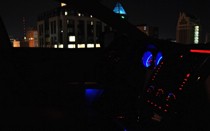
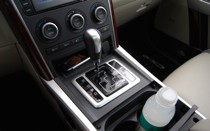
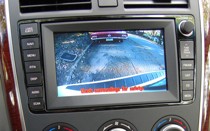
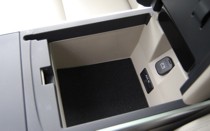
Then there are the electronics. Let's start with the positives. There's an auxiliary jack for your iPod (or whatever 3% marketshare-mp3-player you're using) coupled to a sweet-sounding 10-speaker Bose surround sound system. Packaged with the moonroof, it's almost worth the $1,760 charge. Our CX-9 Grand Touring also had the optional $2,500 GT Assist Package that includes a backup camera and electric open-and-close hatch. The camera's view, unfortunately, didn't help much when parallel parking, but we can see it reducing the risk of running over a careless kid. The dual-zone climate control was nice, and the auto-dimming mirror must have worked since we never noticed it not working.
Possibly the most valuable bit of electronics this Mazda sported was its $200 blind spot monitoring system. Using sensors on all four corners, it detects objects hiding in blind spots and alerts the driver with a lighted icon in the doors' mirrors. Signal a lane change with the icon lit, and the car beeps to get your attention. Unfortunately, that's a sound only courteous drivers will ever know. Hopefully one day such a system will be required on every car sold in the U.S., especially ones with blind spots as big this SUV.


Now on to the electronic negatives, and oh boy were there some negatives in the CX-9's gadgets. Starting at the slightly-annoying end we find the satellite radio interface. Why does Mazda insist on making owners choose their satrad stations by number instead of name? If someone pays $430(!) for a device that lets Sirius beam its programming into their car, why do they need to consult a book just to pick their broadcast? At least I can use the car's touch screen to systematically go through all 198 offerings, but I can do that with a portable $90 satrad unit.
Next on our list of high-tech annoyances for the CX-9 is its standard Bluetooth system. The voice-activated setup is a pretty simple process. And making calls is easy if there's no 2-year-old in the back seat screaming to talk to his grandmother. With even that little bit of noise, the car can't distinguish between an area code and, "Talk Gramma now!" The car then gets confused and calls Bangladesh instead. Theoretically, using your phone's contact list should make dialing easier, but we couldn't get it to work. We would have spent more time figuring it out, but during the few calls we could complete, the other party couldn't understand the conversation so we saw little point. On top of that, every time we got into the car, we had to go through the process of re-syncing the phone. Now that's annoying.


The worst, though, was the CX-9's navigation system. Apparently designed during the Cold War by Soviet engineers, it was clunky, slow and, well, often wrong. Setting a course from Birmingham, Ala., to Atlanta began by entering a home address so the mapping program would know where to start. On several nav systems, that means just asking it to find its location to use as the starting point. The CX-9, however, refused to admit that the street on which it was parked exists. Out comes the owner's manual, which means the car has failed at intuitiveness. Apparently, despite having a built-in global positioning system receiver that costs $2,500, it's up to the driver to tell the car when it has moved from one of its GPS mapping zones into another. Now that's really annoying. But wait, there's more.
With the high-tech, high-dollar, low intelligence nav system informed of its location and destination, two routes were generated. One choice was a fairly straightforward 2.5-hour trip except for an odd turn that took us through industrial parks and residential areas. The second choice was just bizarre. For some reason, the CX-9 thought it might be nice to take a scenic drive on our way to Atlanta through Chattanooga of all places. That alternative would have taken us 118 miles out of our way.

We chose the primary route for obvious reasons, but for backup we had an iPhone with Google Maps loaded. About 12 miles outside Atlanta, the CX-9 wanted us to exit onto surface streets. The iPhone said to continue on the interstate straight to our destination. No problem. We'll just fiddle with the CX-9's route a bit and straighten things out, right? Uh, no. While the CX-9 is in motion, no one, not even the passenger, can alter a route on the navigation system. We continued to follow the route suggested by our iPhone with the nav system begging us to make a legal u-turn.
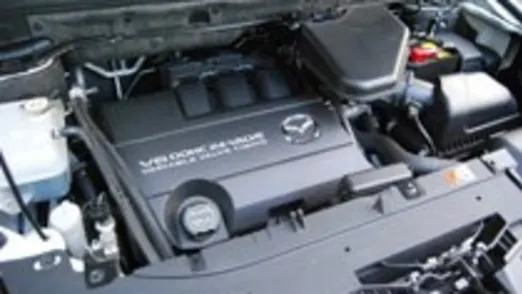

So it seems Mazda has a few things to learn about luxury. But surely the creator of the Miata got the sport part right. Right? Uh, no. We like safety, but we don't like overbearing Dynamic Stability Control systems. Or is it the CX-9's Roll Stability Control? Or maybe its Traction Control System? The first time we went into a quick right-hander, one of the trio kicked in with alarming results. Sure, we were going a little faster than most CX-9 owners ever will, but there were no tires squealing, no imminent danger of flipping like a two-faced politician. Everything was under control until one of the nanny-systems kicked in and abruptly shut down the throttle. We thought we'd blown a tire or hit an open manhole. The revs plummeted, the car came to a crawl, and we were left just past the apex inching along, stunned. Sure, it's a safety feature to be appreciated by typical SUV owners. But CX-9 owners will be disappointed if they try to drive with any manner of enthusiasm. For those who like to have a little fun even when forced into an SUV, we recommend the smaller CX-7. You'll be able to share your driving skills with three fewer friends, but everybody will have more fun.

A 4,300-pound SUV is more likely to be bought by someone looking for minivan alternatives than wannabe race car drivers. And that crowd is a lot more likely to be impressed with the acceleration available from the 273-horse V6 and the quiet, smooth ride. Despite the size of the CX-9, it was fairly nimble in traffic and more easily maneuvered in tight parking garages than you might expect. The ride was very well composed and exhibited none of the typical SUV swaying and bucking.

Some three-row SUVs sacrifice cargo space for that additional seating, but even with all of its seats ready for use, the CX-9 retains a good bit of its rear hauling space and rear-seat passengers even have comfortable leg room. Fold the last row flat and the hauling potential will amaze.
The base price on our 2008 Grand Touring model was $33,355. Delivery charges and options, including a $525 towing package and $200 pearl paint, pushed the final price up to $39,920. Dropping the road rage-inducing navigation saves your nerves and $2,500, which is not too bad considering a top-end seven-seat minivan with fewer amenities would cost almost as much.
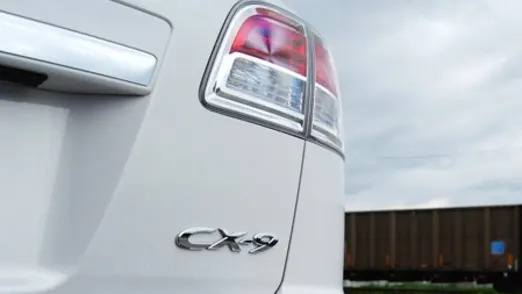
The EPA predicts the CX-9 will get 16 mpg in the city and 22 on the highway for combined average of 19 mpg. We didn't do so well. Our average over 380 miles was only 14 mpg. With the cruise set on 70 mph and the air conditioner on for the entirety of our 120-mile trip to Atlanta, we hit our high point of 17 mpg. Is a vehicle this thirsty still wanted in a world of $4-a-gallon gas?
Shoppers looking for a luxury vehicle that can seat the coach and all the infielders have few choices if a minivan misses the mark. For them, the CX-9 might indeed be "about perfect."
All photos Copyright ©2008 Chris Tutor / Weblogs, Inc.



Sign in to post
Please sign in to leave a comment.
Continue